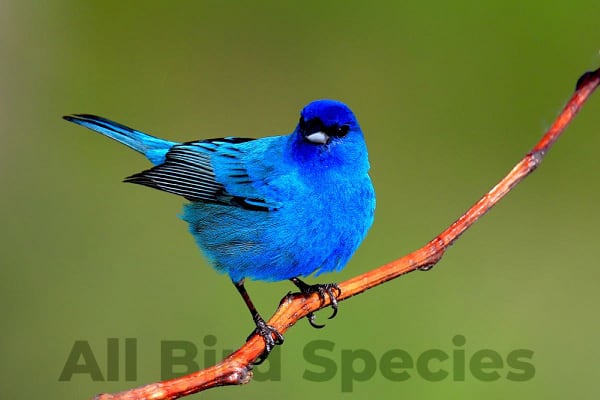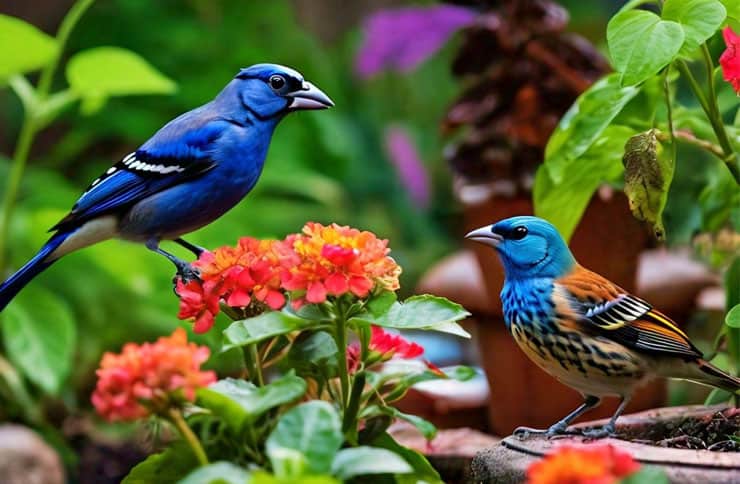Blue Grosbeak Vs Indigo Bunting: What Are The Differences?
Blue Grosbeak Vs Indigo Bunting: As summer arrives, North America welcomes vibrant birds to nest across the country, including the Midwest. Among them are the Blue Grosbeak and the Indigo Bunting, two birds with striking blue hues. These species often share geographic ranges and habitats, making it challenging for birders to distinguish between them. However, there are reliable methods to tell them apart.
Blue Grosbeak vs Indigo Bunting: What’s the Difference?
When you look through your binoculars and spot a quick blue blur, it can be tricky to know what you saw. Was it a blue flash? If you see some black marks on the wings, you can be sure it wasn’t an eastern bluebird or a mountain bluebird. But figuring out if it’s a male blue grosbeak or an indigo bunting can still be hard. Here’s a quick way to identify these birds, so you’ll always know which blue bird popped by your yard.
How to Identify a Blue Grosbeak
Blue grosbeaks are characterized by their large head, stout body, and dark blue feathers, along with two rust-colored wing bars. Their bill is heavy and thick, similar to other birds in the grosbeak family. Females are brown with contrasting wing bars which makes them beautiful.

If you hear a rich, musical warble, it’s likely coming from a blue grosbeak. They also emit a loud chink call when upset.
These birds are commonly found in the southern half of the United States during the summer, but their breeding range is expanding northward. If you’re in the western half of Texas, you’re likely to spot a blue grosbeak.
How to Identify an Indigo Bunting
Indigo buntings are smaller birds, about the size of a sparrow, and are covered in bright blue feathers with some black on their wings and tail. They also have darker blue coloring on their head. Unlike blue grosbeaks, they do not have rusty wing bars. Their bill is small and conical.

Morevoer, The Female indigo buntings are plain light brown with faint wing bars and thin streaks on the chest. When trying to identify females, pay attention to bill size and wing pattern.
These birds sing in quick, sweet phrases.
Indigo buntings are typically found in the eastern United States and parts of the Southwest during spring and summer. If you’re birding in the upper Midwestern states or around the Great Lakes, chances are the mystery blue bird you’ve spotted is an indigo bunting.
Size
Indeed, there’s a noticeable size difference between Blue Grosbeaks and Indigo Buntings. Blue Grosbeaks typically measure between 15 and 16 cm, whereas Indigo Buntings are smaller, ranging between 12 and 13 cm. This means that even a small Blue Grosbeak should be larger than an Indigo Bunting. While it can be challenging to gauge size when observing a single bird, a side-by-side comparison highlights this distinction clearly.
Range
Both the Blue Grosbeak and the Indigo Bunting have slightly different ranges, though there is considerable overlap.
Blue Grosbeaks are found as far south as Central America during winter and as far north as North Dakota in summer. They span from the west coast to the east coast and are commonly found in the southern states. While they are widespread in the United States, their typical range does not usually extend north of Colorado and Indiana.
However, a few individuals are spotted annually during summer in states like Wisconsin. They can also be found farther north in the central part of the country, summering in places like Oklahoma and the Dakotas.
Indigo Buntings, like Blue Grosbeaks, winter as far south as Central America. These bright blue birds inhabit most of the southern United States, except for parts of Arizona and Texas. Interestingly, their range seems to skip over western Mexico. Unlike Blue Grosbeaks, Indigo Buntings venture much farther north in summer. They can be found in every state east of Montana and even in southern parts of Canada.
Bill
You’re right, the bill size is a good clue to tell these birds apart. The Indigo Bunting has a small, cone-shaped bill that’s all one color—gray or silver. On the other hand, the Blue Grosbeak has a bigger bill, and it’s usually two-toned, with the top part darker gray and the bottom part lighter gray. So, if you see a bird with a larger, two-colored bill, it’s likely a Blue Grosbeak.
Field Markings
Yes, you’ve got it! Both birds are blue, but they have different patterns and colors that help tell them apart.
The Blue Grosbeak has a tiny black mask by its beak that goes over the eye, which the Indigo Bunting doesn’t have. The grosbeak also has unique rusty wing bars that are easy to spot. Female grosbeaks aren’t as blue as the males; they’re more of a dark tan or light brown but still have those rusty wing bars.
Indigo Buntings are mostly blue all over, with some gray to black on their wings. They have a bit of black by their beak, but it’s not as much as the grosbeak’s. Female buntings are a lighter tan and don’t have the wing bars that female grosbeaks do.
It’s true, these two species often live in the same places in the U.S. and Mexico. Sometimes they’re even found in areas where you’d usually only see one of them. Knowing how to spot the differences is handy for birdwatching.
Check Our Previous Articles
| Where Do Hummingbirds Sleep at Night |
| What Time Do Birds Wake Up? |
| Common Black Bird With Yellow Beak |
| Types Of Hawks In Georgia |
Frequently Asked Questions on Blue Grosbeak Vs Indigo Bunting
Q1: What is the difference between a blue grosbeak and an Indigo Bunting?
Blue grosbeaks are larger with a bulkier build, while Indigo Buntings are smaller and more slender. Blue grosbeaks have a thicker bill and brownish wingbars, whereas Indigo Buntings have a thinner bill and lack wingbars.
Q2: What is the difference between a bluebird and an Indigo Bunting?
Bluebirds belong to the thrush family and have a softer, more subdued blue coloration with a reddish-brown breast. Indigo Buntings, on the other hand, are in the cardinal family and have a vibrant, iridescent blue plumage with no reddish tones.
Q3: What is the difference between indigo and lazuli buntings?
Indigo buntings are predominantly blue all over with black wings, while lazuli buntings have a blue head and chest, but the rest of their body is a mix of brown and white.
Q4: What is the difference between a painted bunting and an Indigo Bunting?
Painted buntings are more brightly colored with a mix of red, green, blue, and yellow, while Indigo Buntings are primarily deep blue in color with black markings. Additionally, painted buntings have a larger bill compared to the slender bill of Indigo Buntings.







